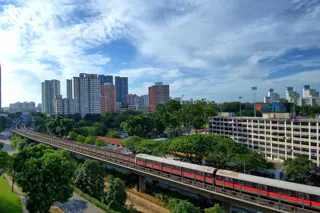
Explore the projected surge in property prices around Shela (Ahmedabad), Vapi, and Bharuch due to the Mumbai-Ahmedabad Bullet Train’s infrastructure boom and economic zones.

The Union Budget 2025 focuses on economic resilience, tax reforms, and infrastructure development, significantly impacting India's real estate sector through various incentives and policy changes.

India’s Tier 2 cities are emerging as prime real estate destinations, driven by smart initiatives, sustainable practices, luxury developments, and improved connectivity.

India's retail landscape is shifting, with Grade A malls thriving while Grade C malls face high vacancy rates. Many struggling malls are being repurposed due to evolving consumer preferences and the rise of e-commerce.

REITs in India offer investors a way to access the real estate market without direct property ownership. They distribute significant earnings as dividends, making them attractive to income-seeking investors. Learn how REITs work, how to invest, and key players in the Indian market.

Selling jointly owned property in India requires the consent of all co-owners. Legal action can be taken if a co-owner sells without consent. This article explores the legal aspects of selling jointly owned property and the differences between co-ownership and joint ownership.

FERA, enacted in 1973, regulated foreign exchange dealings in India. Replaced by FEMA in 2000, which focuses on managing foreign exchange while promoting trade and investments. Key differences include property acquisition criteria, shifting from citizenship under FERA to residency under FEMA.

Cement plastering is crucial for durable walls and a smooth finish in construction. Portland Pozzolana Cement (PPC) is often preferred for its water resistance and superior finish compared to Ordinary Portland Cement (OPC). Various cement grades cater to different construction needs, with Grade 33 commonly used for plastering.

India's real estate sector is transforming with regulatory changes aimed at enhancing transparency, sustainability, and growth, promising a prosperous future for investors and homebuyers alike.

Institutional investments in India's real estate reached over $5.8 billion in 2023, driven by both domestic and foreign investors despite global economic uncertainties.

Suburban real estate investment offers affordability, amenities, and higher returns, while city investments provide established infrastructure. Consider location, connectivity, and property type when deciding where to invest.

Partially agricultural income involves earnings beyond farming. This guide explains its taxation, the differentiation needed for tax returns, and the relevant ITR forms to file.

This article outlines the TDS regulations for cryptocurrency transactions in India, detailing deductions, compliance, and penalties for non-payment.

Explore the landscape of Indian commercial real estate, discussing trends, benefits, and challenges investors face in this evolving market.

Property encompasses tangible assets like land and buildings, and intangible ones like stocks and intellectual property. Understanding these classifications is crucial for investors navigating the Indian real estate market.

Technological advancements, particularly Proptech, are revolutionizing the real estate industry by enhancing transactions, investment opportunities, and property management processes globally.

In India's real estate, "Mend" refers to rectifying property boundaries, crucial for resolving disputes and ensuring legal compliance. It clarifies ownership, aiding buyers and homeowners in navigating complexities and promoting peaceful growth.

Bungalow homes, originating from Bengal, offer compact, easy-to-maintain living with various styles. From California bungalows to Craftsman designs, there's a bungalow for every family size and climate. Explore affordable options and modern 3D designs that blend comfort and style.

India's land use is primarily divided into agriculture (60%), forestry (23%), mining, and human settlements. Agriculture includes net sown area (45%), forest area (23%), and other uncultivated land (32%). Forestry is categorized into reserved, protected, unclassified, and village forests. Human settlements comprise rural (70%), urban (30%), and tribal communities.

This article explores the impact of GST on residential property purchases in India, detailing rates, exemptions, and criteria for affordable housing.

Buying land in India involves property registration fees and stamp duty, ranging from 7% to 10% of the property's cost. These fees vary by state, property type, location, and owner demographics, with women often receiving discounts. Online calculators simplify the process of estimating these costs.

TDS on rental income in India is a crucial aspect of the Income Tax Act of 1961. Both landlords and tenants, including NRIs renting residential properties, need to understand TDS implications to ensure legal compliance and accurate tax handling.

Navigating India's real estate market requires a skilled agent. Prioritize registered brokers with market expertise, strong communication, and client focus. Verify experience, check client reviews, and utilize online platforms for your search.

Registering property in India involves several key steps: property selection, legal due diligence, stamp duty calculation and payment, sale deed drafting and registration, and finally, property mutation in land records.

Choosing the right real estate broker is crucial in India. Look for registered brokers with market expertise, strong communication, and a client-focused approach. Verify their experience, check client reviews, and ensure their interests align with yours.